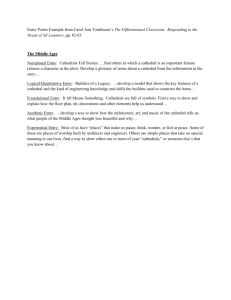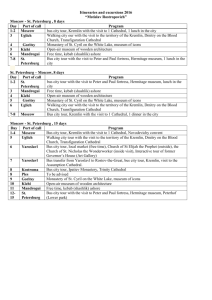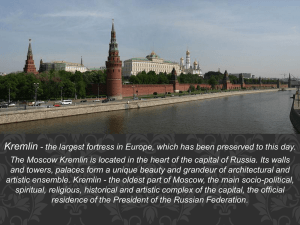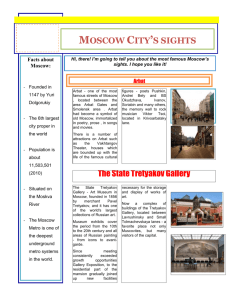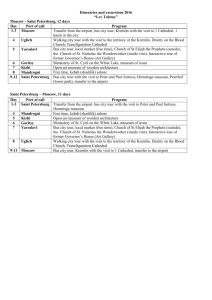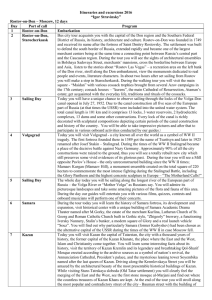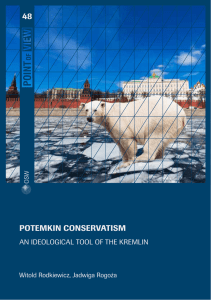The Kremlin
advertisement
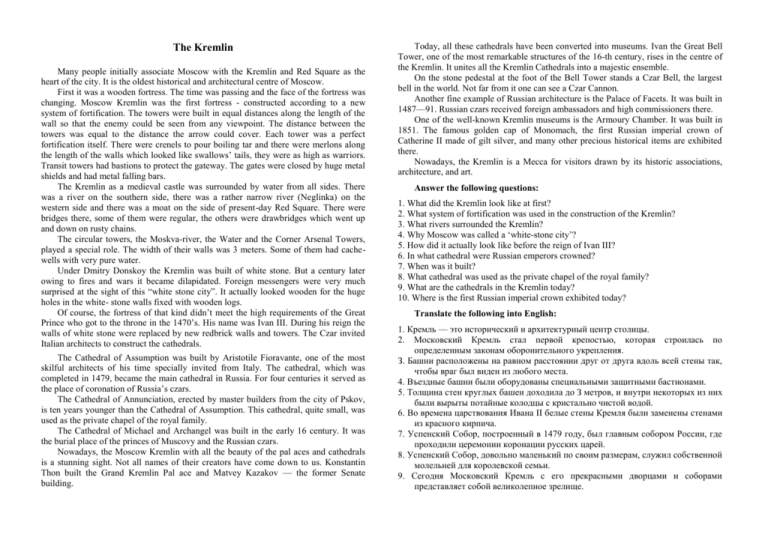
The Kremlin Many people initially associate Moscow with the Kremlin and Red Square as the heart of the city. It is the oldest historical and architectural centre of Moscow. First it was a wooden fortress. The time was passing and the face of the fortress was changing. Moscow Kremlin was the first fortress - constructed according to a new system of fortification. The towers were built in equal distances along the length of the wall so that the enemy could be seen from any viewpoint. The distance between the towers was equal to the distance the arrow could cover. Each tower was a perfect fortification itself. There were crenels to pour boiling tar and there were merlons along the length of the walls which looked like swallows’ tails, they were as high as warriors. Transit towers had bastions to protect the gateway. The gates were closed by huge metal shields and had metal falling bars. The Kremlin as a medieval castle was surrounded by water from all sides. There was a river on the southern side, there was a rather narrow river (Neglinka) on the western side and there was a moat on the side of present-day Red Square. There were bridges there, some of them were regular, the others were drawbridges which went up and down on rusty chains. The circular towers, the Moskva-river, the Water and the Corner Arsenal Towers, played a special role. The width of their walls was 3 meters. Some of them had cachewells with very pure water. Under Dmitry Donskoy the Kremlin was built of white stone. But a century later owing to fires and wars it became dilapidated. Foreign messengers were very much surprised at the sight of this “white stone city”. It actually looked wooden for the huge holes in the white- stone walls fixed with wooden logs. Of course, the fortress of that kind didn’t meet the high requirements of the Great Prince who got to the throne in the 1470’s. His name was Ivan III. During his reign the walls of white stone were replaced by new redbrick walls and towers. The Czar invited Italian architects to construct the cathedrals. The Cathedral of Assumption was built by Aristotile Fioravante, one of the most skilful architects of his time specially invited from Italy. The cathedral, which was completed in 1479, became the main cathedral in Russia. For four centuries it served as the place of coronation of Russia’s czars. The Cathedral of Annunciation, erected by master builders from the city of Pskov, is ten years younger than the Cathedral of Assumption. This cathedral, quite small, was used as the private chapel of the royal family. The Cathedral of Michael and Archangel was built in the early 16 century. It was the burial place of the princes of Muscovy and the Russian czars. Nowadays, the Moscow Kremlin with all the beauty of the pal aces and cathedrals is a stunning sight. Not all names of their creators have come down to us. Konstantin Thon built the Grand Kremlin Pal ace and Matvey Kazakov — the former Senate building. Today, all these cathedrals have been converted into museums. Ivan the Great Bell Tower, one of the most remarkable structures of the 16-th century, rises in the centre of the Kremlin. It unites all the Kremlin Cathedrals into a majestic ensemble. On the stone pedestal at the foot of the Bell Tower stands a Czar Bell, the largest bell in the world. Not far from it one can see a Czar Cannon. Another fine example of Russian architecture is the Palace of Facets. It was built in 1487—91. Russian czars received foreign ambassadors and high commissioners there. One of the well-known Kremlin museums is the Armoury Chamber. It was built in 1851. The famous golden cap of Monomach, the first Russian imperial crown of Catherine II made of gilt silver, and many other precious historical items are exhibited there. Nowadays, the Kremlin is a Mecca for visitors drawn by its historic associations, architecture, and art. Answer the following questions: 1. What did the Kremlin look like at first? 2. What system of fortification was used in the construction of the Kremlin? 3. What rivers surrounded the Kremlin? 4. Why Moscow was called a ‘white-stone city’? 5. How did it actually look like before the reign of Ivan III? 6. In what cathedral were Russian emperors crowned? 7. When was it built? 8. What cathedral was used as the private chapel of the royal family? 9. What are the cathedrals in the Kremlin today? 10. Where is the first Russian imperial crown exhibited today? Translate the following into English: 1. Кремль — это исторический и архитектурный центр столицы. 2. Московский Кремль стал первой крепостью, которая строилась по определенным законам оборонительного укрепления. З. Башни расположены на равном расстоянии друг от друга вдоль всей стены так, чтобы враг был виден из любого места. 4. Въездные башни были оборудованы специальными защитными бастионами. 5. Толщина стен круглых башен доходила до З метров, и внутри некоторых из них были вырыты потайные колодцы с кристально чистой водой. 6. Во времена царствования Ивана II белые стены Кремля были заменены стенами из красного кирпича. 7. Успенский Собор, построенный в 1479 году, был главным собором России, где проходили церемонии коронации русских царей. 8. Успенский Собор, довольно маленький по своим размерам, служил собственной молельней для королевской семьи. 9. Сегодня Московский Кремль с его прекрасными дворцами и соборами представляет собой великолепное зрелище.
